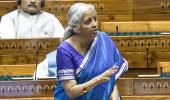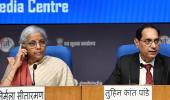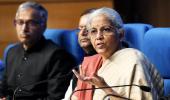'This Budget did not live up to expectations.'

Will the 2025 Budget trigger growth in the economy when there is no demand in the domestic market, when employment opportunities are down, when wages are stagnant, when private investors have no confidence in the market?
"In the middle of 2023, the economy was growing at 8% but by middle 2024, the growth has fallen to less than 6%. That is quite a bit of slowdown in one year. So, I don't think it is a cyclical slowdown. There are many pointers to show that it is a structural problem," Dr Rajeswari Sengupta, Associate Professor of Economics at the Indira Gandhi Institute of Development Research, tells Rediff.com's Shobha Warrier.
Before the Budget presentation, you wrote that the time was ideal for a 'dream Budget' like the one we had in 1991. Now that the finance minister has presented the Budget, how do you describe it?
In the context of what I had written that it was the perfect time to announce a dream Budget 2.0 version, I would say that this Budget did not live up to the expectations.
It is a budget that announced many small easy measures for multiple sectors but in general, it lacked substance and big ideas.
What were the big ideas you would have liked to see? What were the missed opportunities?
Even according to the official GDP data that has many measurement issues and even withstanding those issues, the real GDP growth has been declining in the 4 out of the last 5 quarters.
So, it is not just a one quarter slowdown, it has been happening for the last one year.
In the middle of 2023, the economy was growing at 8% but by middle 2024, the growth has fallen to less than 6%. That is quite a bit of slowdown in one year.
So, I don't think it is a cyclical slowdown. There are many pointers to show that it is a structural problem.
But the government has been repeatedly saying that the economy is structurally strong...
That is the narrative that has been built by this government, that we are structurally strong. When you build such a narrative, there is no reason to announce measures to tackle them.
I will tell you why they are wrong.
If you remember, before the pandemic, by 2019, the economy's GDP growth was down to less than 4% which was the lowest growth rate in two decades.
Everything was slowing down, exports investment, consumption. In fact, consumption declined after 40 years. Everybody has forgotten this.
Then the pandemic happened. It was like a veil in front of everybody's eyes because right after the pandemic, the economy started booming due to the reopening effect.

Was it not expected as the starting point was zero?
Exactly. After the pandemic, the top 5% of the economy started doing extremely well as the largest corporate India gained a lot of market shares during that period. That was because they were able to withstand the pandemic much better than the smaller firms.
So, the classic recovery you talked about was because of the largest firms.
The second thing that happened was this new phenomenon that emerged -- the Global Capability Centres (GCCs) which was outsourcing 2.0. What outsourcing was services in the mid-2000s, now outsourcing is all about R&D, etc.
The new BPOs...
Exactly. As per the reports, there are about 1,400 GCCs in India, and they employ close to 2 million people. And they are generating a lot of high-level income. These people are buying SUVs, imported luxury goods, investing in residential real estate.
This also contributed to the recovery. So, the top started getting very strong and wealthy. It also triggered a little bit of construction boom for a while, along with government capex.

Did this not result in more inequality in society?
Of course. Inequality has always been a problem, and the covid recovery aggravated it significantly.
The point is that it also supported growth. The construction sector was booming, service sector was doing very well, services exports were growing at 20% because of the GCCs. All these were driving the growth for 2 years after the pandemic.
There was euphoria that India was growing at 7% to 8%, and that we were going to be a developed country in two more decades. That was the narrative that was being spun.
But it was not correct. This was not going to be forever.
It was just a temporary boom because this consumption recovery was due to the reopening of the economy after the pandemic.
The GCC boom will taper once the American firms adjust. After that, there will only be incremental GCCs that will be set up in India. So, it will start normalising or plateauing out.
This is what I call the new economy versus the old economy.
The old economy -- the traditional manufacturing sector, the informal sector, goods exports, etc -- has not been doing well at all either before the pandemic or after the pandemic.
The private investment in the old economy has been sluggish for more than 5, 6 years.
And the government capex budget outlay was trying to compensate all these areas with the hope that it would make private sector invest.
Government capex can do only so much, it is only 3% of GDP. The private sector is much larger. It should have started investing when the government was building infrastructure. But it didn't happen.
Then, the goods exports were growing at less than 2%. It was the time many multinational companies were moving out of China, and it would have been a historic moment for India to grab this opportunity as we are a large country with cheap labour, and we would have become a manufacturing export power house.
It didn't happen.
 IMAGE: Rajeswari Sengupta
IMAGE: Rajeswari SenguptaSmaller countries like Cambodia, Vietnam, Bangladesh benefitted...
And India missed the bus.
Now, if you look at FDI, the net FDI has a negative growth in the last two years.
We were not able to capitalise on the opportunity that came on the exports side, and attract FDI.
It was all because there was a lot of policy uncertainty.
The main hallmark of this government has been the PLI (Production Linked Incentive) scheme and it is associated with protectionism. The import tariffs, quality control orders (QCO), etc made trade a protectionist regime.
So, if you have a protectionist regime and a PLI scheme that gives favours to a select few national champions, the multinational companies do not see this as a conducive landscape to come and set shop. They need to import from multiple countries and then export from India.
- Part 2 of the Interview: 'India's Growth Is In Serious Trouble'
Feature Presentation: Aslam Hunani/Rediff.com











 © 2025
© 2025